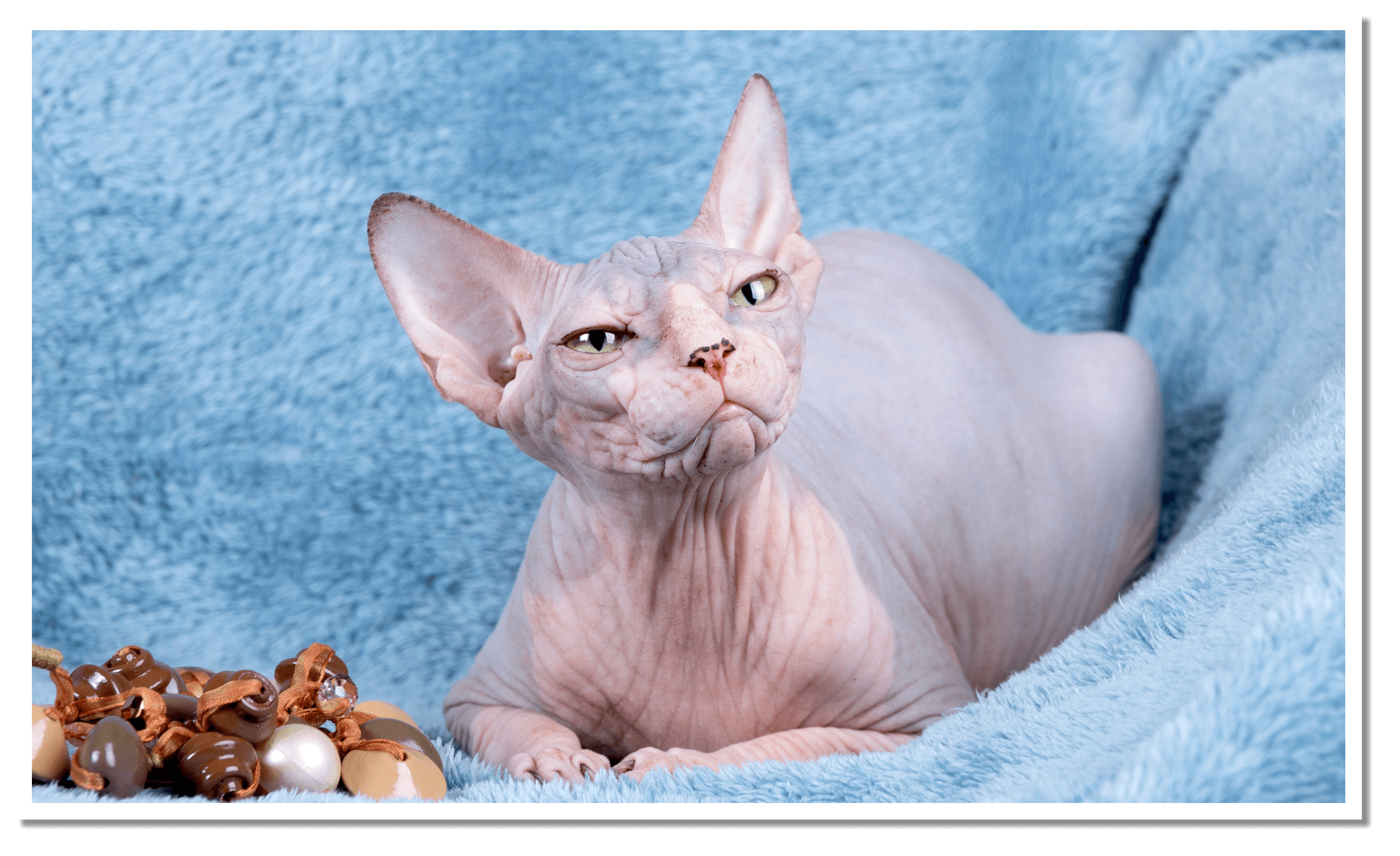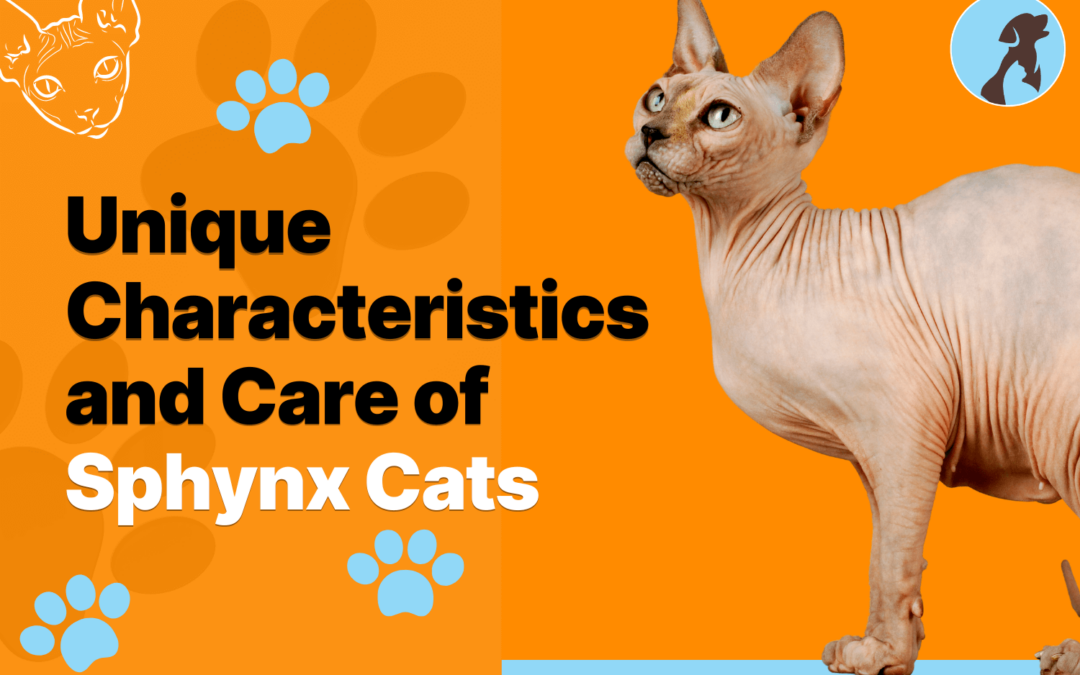Sphynx cats are one of the most distinctive and intriguing cat breeds, known for their hairless appearance and captivating personalities. Originating in the 1960s, the Sphynx cat’s lack of fur is due to a natural genetic mutation, making them a standout in the feline world.
Beyond their unique look, Sphynx cats are celebrated for their affectionate, playful, and social nature, forming strong bonds with their human companions. However, their hairlessness comes with specific care requirements to ensure they remain healthy and comfortable. This guide delves into the unique characteristics of Sphynx cats and provides essential tips on their care, covering everything from skin maintenance to keeping them warm and content.
Whether you’re a current Sphynx cat owner or considering adding one to your family, understanding their special needs will help you provide the best possible care for these remarkable pets.

Distinctive Physical and Behavioral Traits of Sphynx Cats
Physical Traits
Hairlessness
-
- Skin: The most striking feature of Sphynx cats is their lack of a traditional fur coat. Instead, they have a fine layer of downy fuzz, which gives them a suede-like texture.
- Wrinkles: Sphynx cats often have pronounced wrinkles, particularly around the face, neck, and shoulders. These wrinkles are a key breed characteristic and contribute to their unique appearance.
- Color Patterns: Despite their lack of fur, Sphynx cats come in various colors and patterns, visible on their skin. These can include solid colors, tabby patterns, and even spots or patches.
Body Structure
-
- Build: Sphynx cats have a muscular and medium-sized body with a sturdy build. They are surprisingly solid and heavier than they appear due to their muscle mass.
- Head and Face: They have a wedge-shaped head with prominent cheekbones, large ears, and lemon-shaped eyes that can be of any color.
- Tail: The tail is long and whip-like, often described as resembling a rat’s tail. Some Sphynx cats may have a slight tuft of fur on the tip of the tail.
Temperature Sensitivity
-
- Warmth: Without a fur coat, Sphynx cats are sensitive to temperature changes. They seek out warm places and may need additional warmth in colder climates, such as sweaters or heated beds.
- Sweating: Unlike other cats, Sphynx cats can sweat through their skin, which can leave an oily residue. Regular bathing is essential to keep their skin clean and healthy.
Behavioral Traits
Affectionate Nature
-
- People-Oriented: Sphynx cats are known for their loving and affectionate nature. They thrive on human attention and enjoy being held, cuddled, and petted.
- Social: They are highly social and tend to form strong bonds with their owners. They often follow their humans around the house and want to be involved in all activities.
Playfulness
-
- Energetic: Sphynx cats are active and playful. They love interactive toys, climbing, and exploring their environment.
- Curiosity: Their inquisitive nature means they enjoy investigating new things, often getting into playful mischief.
Intelligence
-
- Problem-Solvers: Sphynx cats are intelligent and can quickly learn tricks and commands. They enjoy puzzle toys and activities that challenge their minds.
- Communication: They are vocal cats and will communicate their needs and desires through a range of sounds, from meows to purrs.
Compatibility with Other Pets
-
- Friendly: Sphynx cats generally get along well with other pets, including cats and dogs. Their social and friendly demeanor helps them integrate well into multi-pet households.
- Non-Aggressive: They are typically non-aggressive and enjoy playing with other animals, often establishing close bonds.
Health Considerations
-
- Regular Vet Visits: Due to their unique needs, regular veterinary check-ups are essential to monitor their skin health and overall well-being.
- Diet and Nutrition: A balanced diet is crucial to maintain their health, and their higher metabolism means they may require more frequent meals compared to other cats.
Comprehensive guide on grooming and skin care for hairless sphynx cats
Grooming and skin care for hairless Sphynx cats are crucial aspects of their overall health and well-being. Without the protection of fur, their skin requires special attention to keep it healthy and free from issues like oil buildup, acne, and sunburn. Here’s a comprehensive guide on grooming and skin care for Sphynx cats:
-
- Bathing: Sphynx cats need regular baths to remove excess oils and dirt from their skin. Use a mild, hypoallergenic cat shampoo recommended by your veterinarian. Bathe your Sphynx once every 1-2 weeks to maintain skin cleanliness.
- Water Temperature: Make sure the water is lukewarm, not too hot or too cold, as extremes can be uncomfortable for your cat.
- Drying: After bathing, gently pat your Sphynx dry with a soft towel. Avoid vigorous rubbing, as their skin is delicate and can easily become irritated. You can also use a hairdryer on a low, cool setting to speed up the drying process.
- Moisturizing: Sphynx cats have naturally oily skin, but some individuals may benefit from moisturizing. Consult your veterinarian for recommendations on moisturizers suitable for your cat’s skin type. Avoid products containing harsh chemicals or fragrances.
- Ear Cleaning: Sphynx cats are prone to wax buildup in their ears, which can lead to infections. Clean their ears regularly using a damp cotton ball or a veterinarian-approved ear cleaner. Be gentle and avoid inserting anything into the ear canal.
- Nail Trimming: Trim your Sphynx’s nails regularly to prevent them from becoming too long and causing discomfort or snagging on furniture. Use a pair of cat nail clippers and be careful not to cut the quick (the pink area containing blood vessels).
- Eye Care: Sphynx cats may produce more eye discharge than other breeds due to their lack of fur around the eyes. Use a damp cloth to gently wipe away any discharge. If you notice excessive tearing or signs of infection, consult your veterinarian.
- Sun Protection: Sphynx cats are vulnerable to sunburn, especially on their ears, nose, and other exposed areas. Limit their exposure to direct sunlight, particularly during peak hours, and consider using pet-safe sunscreen on sensitive areas when they’re outdoors.
- Environmental Temperature: Sphynx cats are sensitive to temperature extremes. Keep your home comfortably warm in cooler weather, and provide plenty of shade and cool spots during hot weather to prevent overheating.
- Regular Veterinary Check-ups: Schedule regular check-ups with your veterinarian to monitor your Sphynx cat’s overall health, including their skin condition. Your vet can provide personalized advice and recommend any necessary treatments or adjustments to your grooming routine.
By following these grooming and skin care tips, you can help your hairless Sphynx cat stay clean, comfortable, and healthy for years to come.
Tips on maintain sphynx body temperature and ensuring they stay warm
Maintaining the body temperature of Sphynx cats is crucial, as they lack the insulation provided by fur and are more sensitive to temperature changes. Here are some tips to help ensure your Sphynx stays warm:
-
- Provide Warmth Indoors: Keep your home comfortably warm, especially during colder months. Maintain a consistent temperature by using central heating or space heaters. Make sure there are cozy spots for your Sphynx to snuggle up, such as soft blankets or heated cat beds.
- Layering Clothing: Consider dressing your Sphynx in cat clothing, such as sweaters or shirts made of soft, breathable materials. This can provide additional warmth, especially in cooler environments or if your cat tends to get chilly easily. Just make sure the clothing fits comfortably and doesn’t restrict movement.
- Heated Beds or Pads: Invest in a heated cat bed or heating pad designed for pets. These products provide a warm, cozy spot for your Sphynx to relax and sleep. Always follow the manufacturer’s instructions and choose products specifically designed for pets to ensure safety.
- Provide Warmth During Travel: If you’re traveling with your Sphynx or taking them outside during colder weather, ensure they stay warm by using a pet carrier with blankets or a small heating pad. Avoid exposing them to cold drafts or extreme temperatures for extended periods.
- Limit Outdoor Exposure: Sphynx cats are more susceptible to temperature extremes, so it’s best to limit their outdoor exposure, especially during very hot or cold weather. If your Sphynx enjoys spending time outside, consider creating a safe, enclosed outdoor area or supervised play sessions.
- Keep Them Dry: Moisture can increase the risk of hypothermia in Sphynx cats. Make sure your Sphynx stays dry, especially after bathing or if they get wet outdoors. Use a towel to gently dry their skin and fur, and avoid prolonged exposure to damp or humid environments.
- Monitor for Signs of Cold Stress: Pay attention to your Sphynx’s behavior and body language for signs of cold stress, such as shivering, seeking warmth, or curling up in a tight ball. If you notice any signs of discomfort or cold, take steps to warm them up immediately.
By following these tips and providing your Sphynx cat with a warm, comfortable environment, you can help ensure they stay cozy and healthy year-round.
Conclusion
In conclusion, Sphynx cats captivate with their distinctive hairless appearance, playful demeanor, and affectionate personalities, yet their uniqueness demands special care considerations. Owners must prioritize skin health through regular bathing, moisturizing, and sun protection, while also ensuring adequate warmth in cooler climates through indoor heating, clothing, and cozy bedding.
With attention to grooming, social interaction, and routine veterinary care, Sphynx cats can thrive, becoming cherished companions known for their exceptional charm and boundless affection.


Very informative!